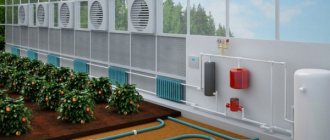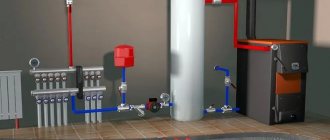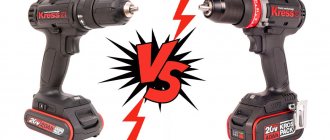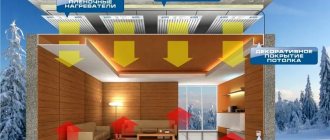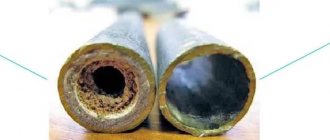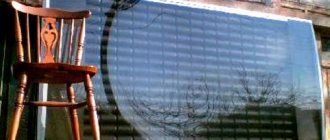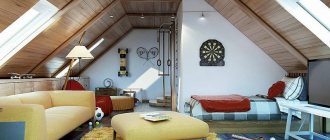An unusual heating technology, fundamentally different from the usual systems with radiators under the windows, came to us from European countries recently, although it has been used there for more than twenty years. The name of the innovation speaks for itself - warm baseboard, the demand for it is growing due to its technical advantages and modern design.
You will learn everything about the types of baseboard heating and the features of its operation by reading the article we have proposed. We will talk about the design specifics and rules for constructing all types of baseboard heating systems. Here you will find out where heating baseboards are used and which models are popular among consumers.
Objectively about all the advantages and disadvantages
The ascending heat flow, according to Coanda's physical law, is pressed against the wall.
Without mixing with the rest of the air in the room, it heats the vertical surface. At a height of up to one and a half meters, the wall temperature is several degrees higher than in the room, and this creates thermal comfort for the people in it. During the heating season, the heating system is used for 6-8 hours every day. By multiplying the total power by the number of hours worked per month, we get the monthly energy consumption indicator.
The distribution manifold evenly distributes the coolant among the individual circuits. Its choice is determined by a number of factors - product material, comb throughput, pressure, energy consumption, possibility of further expansion
Do baseboard heaters really save energy resources due to the low temperature of the coolant?
The answer would be this example:
- Room area - 3.5m x 5m (17.5 sq. meters), perimeter - 17 m (minus the doorway - 16 m).
- Room volume with a ceiling height of 2.7 m: 17.5 * 2.7 = 47.25 cubic meters. meters
- The outside temperature in winter is on average -10 ºC.
- To maintain +20-22ºC in a room with normal thermal insulation, 1.5 kW/hour is required. The heating will operate 7 hours a day.
Taking into account 200 W per 1 meter of length when heating the coolant to 65 ºС (see above), we get 200 W * 16 m = 3200 W or 3.2 kW. Since this flow rate is twice as high (3.2 kW/1.5 kW = 2.1), it is possible to reduce the coolant temperature in the same proportion: 65 ºС / 2.1 = 31 ºС.
Let's calculate the monthly electricity consumption: 1.5 kW/hour * 7 hours. * 30 days = 315 kW. More reliable results are obtained by detailed thermal engineering calculations based on complete initial data on the object.
If we compare the efficiency of heated floors and baseboards, then we can argue, if only for the reason that convectors from the floor immediately heat the air, and part of the warm air from the baseboard is taken over by the outer wall, which is constantly fed by the cold outside.
The heat spent on constant heating of cold external walls is a kind of loss. Is their dryness, lack of mold, and dampness a compensation for this? There is also debate on this issue: some say yes, others point out that the humidity in the room is regulated by supply and exhaust ventilation, and not by heating.
If water radiators are connected in series, the coolant will cool while it goes around the entire perimeter. Therefore, the modules are combined in parallel, each pair of incoming and outgoing pipes is output to the collector separately
As for the appearance, the baseboard boxes that cover the heating really look beautiful in the interior, but when there is cabinet furniture in the room, problems arise - it is not possible to go around it in front, and behind it the warm air does not have freedom of movement.
And regarding the absolute absence of dust in the air, it is worth objecting - perhaps there is less of it than with air circulation in traditional heating systems, but it is there, since convection is present.
In general, we can conclude that baseboard heating radiators already have buyers, and over time their number will increase. The limiting factor is the excessively high cost of equipment, which is explained by the use of copper, brass, aluminum in production, i.e. expensive materials.
And installation, if you order it from professionals, is not cheap. Skirting pipe routing is the most complex of all available water heating circuits, but there are also many nuances in the assembly of electric baseboards.
Microclimate regulation and additional equipment
When installing a contour heating system, especially if you make a warm water baseboard with your own hands, it is necessary to create a control structure and install some additional components
The presence of the latter is especially important. If a warm baseboard is made in an apartment and connected to heating risers, it is important not to violate the operating parameters of the centralized heating supply system
Adjustment system
To regulate the amount of heat entering the room, in the simplest case, shut-off valves can be used. An ordinary tap installed at the entrance to the circuit can change the amount of coolant pumped per unit of time. This is convenient in conditions of stable water temperature in the circuit and the outside climate: you can increase or decrease circulation several times a season “by eye.”
Automated systems are more functional. In this case, a thermal head is installed at the output of the circuit. Such a valve, roughly speaking, controls the drop in temperature and shuts off the circulation at set levels of water that has passed through the heating system.
Thermal heads with an external temperature sensor are more convenient. They receive a signal from small devices located indoors that determine the microclimate and set the heating operating mode.
Thermal heads with external control can also receive data on the air temperature outside the building in order to accordingly increase or decrease the heat transfer from the baseboard.
Thermal head
Circulation pump
Equipping a warm baseboard circuit in an apartment is a necessary step if the heating system of the house is built on a supply-return circuit with mixing. In such a structure, the gravitational principle of coolant movement is used. The warm water baseboard is deprived of it. Therefore, forced pumping of water through the system will be required.
In apartments with a through circulation circuit (heating radiators without a mixing tube between the supply and return), the use of your own pump for a warm baseboard will allow you not to influence the pressure indicators existing in the centralized heating system.
Circulation pump circuit
Is there enough energy from baseboards in our climate?
It is easy to calculate that the perimeter of a room of 20 square meters will be 18 meters. Of these, 5 meters will be occupied by furniture near the wall, a doorway (a room without sofas, beds, wardrobes, chests of drawers against the walls is not functional...). In total, you can expect to receive 1.4 kW at 40 degrees of heating. At the same time, the recommended minimum heat loss for such a room is 2.0 kW (100 W per square meter), and if it is a corner room with large glazing, then 3.0 kW, but this is for well-insulated buildings. Thus, at a nominal temperature of 40 degrees, there is simply not enough power for the cold month. A rise in temperature threatens gigantic heat loss and loss of comfort (more on this later).
Separate sections of warm baseboard are connected by flexible pipelines with compression fittings via copper pipes
Heating in baseboards: advantages and disadvantages
There are quite a lot of advantages of baseboard heating, and we have already mentioned a couple of very significant ones above. Now it remains to add a little to this list - as they say, to give it real outlines.
- Uniform heating of the room. It cannot be otherwise with this principle of arranging heaters. Moreover, the uniformity of heating also lies in the fact that throughout its entire height the air gap between the floor and the ceiling will have almost the same temperature.
- Rapid heating of the room due to the use of convector type heaters - they accelerate the air due to their special design. So to speak, accelerated air convection in the room.
- High aesthetic characteristics. The key point is that they are used “instead of baseboards.” This indicates not only the small size of the heating radiators, but also that they do not spoil the appearance of the room in any way - from a design point of view, these are the most attractive heating devices for residential premises.
- Economical in operation and maintenance. The question, of course, is controversial and largely depends on the type of baseboard heating system. If we talk about electric baseboard heating, it can hardly be called economical.
Naturally, baseboard heating distribution, or rather the system of such heating of a house itself, as they say, is not without its drawbacks, but this heating complex does not have many of them. Firstly, the high cost of the system, which will have to be paid for operational efficiency and simple maintenance - both the equipment itself and the installation work will be expensive. Secondly, baseboard heaters turn out to be ineffective behind furniture - in most cases, if not almost 100 percent of the time, they are not installed behind sofas and wardrobes, which not only reduces the efficiency of the system as a whole, but also creates some inconvenience. For example, if there is a need to rearrange the furniture, then you cannot do without altering the baseboard heating - so everything needs to be thought out in advance.
Rules for choosing a device
When choosing an electric type in-floor convector, the main thing is to evaluate the power and dimensions of the device. It is also advisable to decide on the type of convection, which can be natural and forced.
The choice of water heaters built into the floor requires taking into account many parameters of the functional features of the device.
Main characteristics of the convector
Initially, you need to select the size of the product, the presence of a fan, the material of the housing, fins, pipes
In addition, you need to pay special attention to other characteristics
When considering a built-in water-type convector as a home heating device, you should decide on the manufacturer.
Domestic and foreign manufacturers offer heating devices with a wide power range. By choosing this parameter correctly, you will ensure a comfortable room temperature
One of the most important characteristics of a convector is the type of heating system - single-pipe or two-pipe. Connection diameters are not the primary selection criteria, since adapters are available.
Heating system pressure
This is one of the most important indicators of a water device. Any model is suitable for heating a private house, two-story and three-story cottage, since the pressure in the general heating system is usually no higher than 3 bar.
Usually, for installation in multi-storey buildings, it is recommended to install convectors built into the floor, the operating pressure of which is up to 15 Bar
For high-rise apartments, it is necessary to take into account the pressure testing and working pressure. The operating organization should find out these indicators for your home by comparing them with the characteristics of the selected model.
Selecting a coolant option
When choosing the optimal model of an in-floor convector, it is necessary to take into account the type and parameters of the device. Any model is suitable for individual heating, since the owner of the premises can independently set and control the temperature and characteristics of the coolant.
Residents of high-rise buildings will have to adapt to the conditions and indicators of the water that flows in the sewer pipes. In this case, the following factors should be taken into account: temperature, amount of suspensions, Ph, oxygen content, optimal type of device connection.
Types and features of installation of baseboard heating
Baseboard heating can be either electric or water. Both are easy to install both in new and in used premises with existing heating.
Water baseboard heating
An autonomous water heating system consists of a boiler, distribution manifold, radiators and plastic pipes placed inside corrugated cross-linked polyethylene tubes. Supply pipes are laid from the distribution manifold to the baseboard installation areas along the floor or along the walls. Thanks to the corrugated outer pipe, which acts as a casing, replacement of failed supply pipes is carried out without dismantling and opening the floor screed.
The distribution manifold consists of a pair of steel pipes equipped with outlets and inlets, air vents and thermal valves. The top pipe is connected to the boiler and supply pipes leading to the radiators. The lower one is designed to return the cooled coolant.
The operating principle of the liquid system is no different from the usual design with traditional wall-mounted batteries. The heated coolant is supplied to the collector, from where it flows through pipes to the radiators. Skirting heating installations are much more efficient, simpler and more economical than “warm floors” and can be installed on any floor covering, including laminate and parquet.
Baseboard heating radiators consist of two copper tubes surrounded by metal plates that increase heat transfer. The elements are covered from above with decorative aluminum boxes, hiding the structure and evenly distributing heat. The standard height of the plinth is 14 cm with a thickness of about 3 cm. The color of the box is easy to match to the type and shade of the floor or wall.
In a liquid baseboard system with plastic pipes, any coolant can be used, but its temperature cannot exceed 80 degrees, and the pressure should not be higher than 3 atmospheres. In cases where the operating parameters exceed the declared values (which is often found in multi-storey buildings), it is necessary to install an additional heat exchanger in the apartment, which protects the central heating from overload. Another option is to install copper pipes instead of plastic ones.
The system is ready to connect
Electric warm baseboard
An electric baseboard heating system is practically no different in appearance from a liquid heating system, but instead of a coolant, the radiator tubes contain heating elements and power cables. The power of tubular electric heaters is 200 W per meter. The heaters are connected to the electrical network through a thermostat that regulates the set temperature in the room. To obtain maximum comfort, it is recommended to place temperature sensors at human height.
Installing an electric heated baseboard is much simpler than installing a water version. The system can be hung on any surface, including wooden walls and plasterboard partitions. The working elements are fixed on the walls at a distance of 4-6 cm from the floor, using special holders for fastenings. For safety reasons, it is recommended to use a residual current device.
The baseboard heating system does not have to be laid along the entire perimeter - the length of the heater is calculated depending on the volume of the room. In some cases, warm baseboards are used as auxiliary heaters in addition to underfloor heating or another type of heating.
Installing baseboard heating yourself can lead to serious breakdowns and accidents. It is better to entrust this difficult work to specialists who have the appropriate knowledge and experience in working with heating equipment.
Design, scope, price
Thin, elegant heaters that harmonize with the overall decor allow you to implement the most non-standard design ideas.
The peculiarity of the baseboard heating system is that it does not take away any free space from the room, and it can be placed next to furniture, antiques, household appliances, and musical instruments.
The material from which the flooring and walls are made also does not matter - there will be no damage or harm.
A palette of hundreds of colors and shades makes it possible to choose the appearance of the case to your liking. The texture can be a flat and smooth surface or an imitation of granite stone, marble, or wood.
A baseboard radiator will equalize the temperature in colder corner and end rooms; owners of cottages and country houses who want to create an elegant interior in their homes are interested in this technology. And in high-rise buildings, many people want to heat loggias and balconies, and this task is also easily solved using a similar heating scheme.
Wherever baseboard heating is used - in greenhouses and winter gardens, swimming pools and gyms, in museum buildings, concert halls, etc. Panoramic construction is in fashion, but you cannot install ordinary radiators along a wall that is solid glass.
A wide range of textures and shades of the warm baseboard body allows it to be used as a decorative element. In this case, it merged into a single whole with the door frames
Traditional heating also loses in rooms with high ceilings. No matter how much you heat them with radiators, warm air will still rush up to the ceiling, leaving the lower zone cool, and with the help of a thermal baseboard the situation can be easily corrected.
As for the price, the purchase and installation of heated baseboards is comparable to the cost of heated floors. Both will not be cheaper than installing a classic heating system with batteries.
Unfortunately, all energy-efficient devices cannot be called cheap, but the costs are worth it. In order not to overpay, you need to complete the system in advance - each of its elements has its own price. Only a specialist can do this correctly.
Classification of baseboard heating
Baseboard heating networks are classified into two types:
- electrical;
- aquatic.
The main elements of water baseboard heating are plastic, oxygen-permeable tubes, a distribution manifold, and baseboard batteries.
A baseboard heating system is installed in addition to the main heating of an individual house only when the coolant heats up by less than 85°C and the pressure in the central heating system does not exceed 3 atmospheres. Restrictions that should be taken into account when installing the system are imposed due to the possibility of water hammer.
When installing a water baseboard heating system, you must adhere to these instructions
- Copper ones should be preferred to ordinary PVC pipes;
- a heat exchanger is installed that takes heat from the main heating and is built into the system using special copper plates;
- thermostats can be installed on all batteries;
- a servo drive is installed on the distribution manifold;
- a pressure gauge, thermometer, and circulation pump are installed.
Water baseboard heating Electric baseboard heating is implemented according to a simpler scheme.
The main element of the system is a specific radiator unit with a heating element. A tubular electric heater is placed in the lower radiator tube, and the power cable runs in the upper one. This type of baseboard heating cannot be used in rooms with high air humidity. The system is powered from a standard 220 V outlet.
Purpose
Skirting heaters can serve as both the main source of home heating and as an addition to the existing heating system.
Depending on the type of heating elements, they can be installed in private houses, apartments, loggias, garden houses, garages, winter gardens, and industrial premises. Electric cable skirting boards, for example, are used where placement of other heating systems is impossible. Baseboard heating pipes protect the wooden parts of the house well from dampness. Heating baseboards work effectively in rooms with panoramic windows. Thanks to the rising warm flow, the rooms are heated completely and evenly, large windows do not fog up.
Types of baseboard heating
Baseboard heating is divided into water and electric. Accordingly, water systems operate on the basis of gas or any other boilers. Electrical systems are built on the basis of baseboard electric convectors.
Water systems
Water heating systems are built on the basis of the radiators described above, made of non-ferrous metals. Hot coolant, prepared by a heating boiler or obtained from a central heating system, circulates through them.
Water baseboard heating can be used to heat rooms for any purpose - these can be halls, corridors, kitchens, children's rooms, living rooms, shopping areas and much more. In addition, it is well suited for use in rooms with panoramic glazing - baseboard radiators will prevent the penetration of cold and protect against the formation of condensation.
The “warm baseboard” heating system is recommended for installation in individual households. But its use with a centralized coolant supply can lead to an accident - baseboard heating does not tolerate water hammer. Some experts recommend using an intermediate heat exchanger, but in this case certain heat losses will be observed.
A water baseboard heating system consists of the following parts:
- Radiators - they are miniature convectors made of non-ferrous metal. They are the sources of heat for heating rooms;
- Protective boxes - they cover the radiators and pipes themselves;
- Pipes - in most cases, metal-plastic pipes are used here, as they are more resistant to pressure and high temperature.
The installation of a water baseboard heating system is carried out in such a way that it does not form a complete ring throughout the house - this would cause uneven heating. Therefore, the most common practice is to create separate directions for each room. To do this, distribution manifolds are installed in the heating system, to which coolant is supplied from the boiler.
The main advantage of using a distribution manifold is the ease of repair work in the event of an accident. It will also allow you to adjust the temperature in each direction separately.
Electrical systems
Electric baseboard heating is intended for use in buildings not connected to gas mains. It involves the use of small-sized convectors, powered from the mains. In their design, they are similar to water radiators, only instead of tubes with hot coolant, powerful heating elements are used here.
Electricity in our country is quite expensive, so using electric heating can lead to high costs. But in many cases it remains the only available heating method.
As in water systems, in electric heating it is desirable to use a circuit with several separate directions. That is, each room is powered by a separate electrical cable. A special electrical panel is installed in the building, in which circuit breakers are installed. From here the cables disperse throughout the rooms. If a room is not in use, it can be turned off, thereby saving energy.
Electric convectors work on the same principle as water ones - they produce heated air, which seems to “stick” to the walls and is sent upward. At the same time, cold air masses are sucked into the equipment and undergo the next heating stage. After some time, the room will become noticeably warmer.
The main advantages of electric baseboard heating over water systems:
- Increased reliability - the use of modern heating elements allows us to guarantee a service life of up to 20-25 years, while for water appliances this period is about 10 years;
- There is no coolant - which means there is no risk of flooding the neighbors;
- Easier installation - laying the cable is much easier than fiddling with pipes.
The main disadvantage of any electric heating is its gluttony in terms of electricity consumption - combined with electricity tariffs, the costs will be high.
Difference between the system and others
The operating principle of a conventional radiator is based on heating the air temperature using thermal radiation in the infrared range, as well as convection. But this technique has numerous disadvantages:
- The device must be installed in several places within the same room. The system is complicated by the mandatory supply of a pipeline for supplying coolant and the need to use a large number of component parts.
- Due to the fact that radiators provide heat locally, the temperature of the liquid has to be constantly changed.
- The walls heat up unevenly, which contributes to the formation of mold.
- To increase the efficiency of heating devices, special regulators will be needed.
- Some models have narrow internal ducts. Sometimes mechanical impurities accumulate in them.
You can eliminate the above disadvantages by installing batteries one after another. But the design in this case will turn out to be excessively cumbersome.
Water thermal baseboard solves many problems:
- Special technology prevents cold penetration inside.
- Increasing the temperature of building structures helps to destroy the environment favorable for the proliferation of pathogenic microorganisms.
- There are no so-called empty zones that are not protected by a special screen.
- Cold air does not accumulate in the lower part.
- There is no active movement of contaminants, dust and allergens in the room.
Installing baseboard heating - a detailed guide
When calculating the efficiency of baseboard heating, as for other systems, the standard indicator is 100 W of thermal energy per square meter of room area.
When using the system as additional heating, to calculate the power of the heating devices, simply multiply the area of the room by the standard indicator. And if this system is the main one, then another 20-25% of power must be added to the result obtained. Step-by-step installation is carried out as follows:
- The collector is being installed;
- The pipeline route is marked;
- The required length is measured from the collector to the radiator connection point. Two sections are cut plus 20 cm for connection. The tube is inserted into a protective casing and covered with protective tape.
- Installation of supply and coolant pipes to the radiator connection points is being carried out. The ends of the pipe are fixed in the floor or walls;
- The floor is poured with concrete or the laying channels in the walls are sealed;
- The screed is poured, the underlay and the finished floor with coating are installed;
- Thermal insulation tape is laid around the entire perimeter;
- After this, an aluminum profile is installed and screwed to the floor;
- An aluminum frame profile is installed along the entire perimeter, holders and brackets are installed every 40-45 cm;
- The tubes with plates are installed on the brackets;
- Connecting corrugations and couplings are installed, connections are made to the supply and return pipelines;
- All elements are fixed on brackets;
- A connection is made to the manifold, a pressure test is carried out and then a test fire is carried out;
- After eliminating the leak, a decorative casing is installed.
As you can see, installation of the system is in many ways similar to laying a heated floor pipeline, with the only difference being that the installation of external baseboard panels is also done here.
Electric convector power calculation
When calculating the required convector power, you should adhere to the following rule. For every 10 sq. meters you need 1 kW of heat. Provided that the ceiling is about 2.7 m high. Ideally, each window should be equipped with a device of the same length as the width of the window opening. The second option for calculating power is the following ratio: per 1 cubic meter. meter of room should be from 35 to 40 W of heat, taking into account the heat losses that occur in corner rooms, rooms near the basement and attic. For such rooms you need to take devices with a power reserve. Otherwise, the heater will not provide the required temperature and, as a result, will work continuously.
Installation of warm baseboard
For installation you will need tools: adjustable wrenches in a set, a drill with an impact function (or a hammer drill), a hammer, wire cutters, pliers, scissors (to cut plastic). A baseboard heating system can be quickly installed if the connection points are prepared in advance.
Even before purchasing the necessary equipment, you need to plan what power the heating elements need and how to place them around the perimeter of the room.
Assembling a water heating system
Stage 1. We measure the distance from the point where the distribution manifold will be located to the location of the baseboard. We cut two lengths of the protective pipe and two with an allowance of 20 cm for the connecting pipe. We insert the connector into the protective one, and seal the ends with adhesive tape to protect it from dirt.
Installation of a water baseboard heating system: red - main flow, blue - return. The return flow pipe must be located higherStage 2. We pull the pipes along the floor without tension so that if extensions are necessary, one or more can be laid nearby. We fix it with mounting tapes, cover it with a protective solution, protecting it from damage, and place it in the right place on the wall 6 cm above the floor and 10-15 cm from the edge of the wall or corner, fix it with cement.
Stage 3. After laying the finished floor, we continue work. We glue an insulating strip along the entire length. We stretch the aluminum edge (also along the entire length of the heating), covering the junction of the wall and the floor. Screw it or secure it with adhesive tape or silicone.
Stage 4. We lay a special profile along the top line, put holders on it at a distance of 15 cm from the corners and every 40 cm along the wall.
Stage 5. To connect heating pipes and heating elements, we use couplings with nuts, bushings and gaskets, in the corners - 90º corner rotary tubes, in the ends - 180º end rotary tubes and plugs. We connect the thermal sections with adapters.
When connecting the heating module, you need to remove 2-3 lamellas from the edge and put connecting nuts, crimping parts, and rubber gaskets on the tubes
Stage 6
We carefully press the connected heating sections into the holders. We put on decorative panels (attach with screws or snap on) and decorative corner elements. We connect the system to the manifold, fill with water, test at operating and maximum pressure
Like all collector systems, the heating baseboard requires a circulation pump to stimulate the movement of the coolant. Without a pump, it is difficult for heated water to circulate along an extended circuit. However, the use of technical devices affects the overall cost of the system.
The plinth will work if all technological operations were performed without violations. If there is a leak, the problematic connections must be tightened with a wrench. The coolant is supplied through the collector by a circulation pump from the boiler or from a general (centralized) heating system.
Electric heating system assembly
For a warm baseboard, a separate circuit breaker must be made in the electrical panel. Its power is determined by the number of heating modules.
Stage 1. We supply power to the distribution box, which should be near the location of the system at a height of 4-6 cm from the floor.
Installation of an electric heating system: most often, the electric system is used where it is possible to supply the required power, or in small rooms as additional heating
Stage 2. Apply insulating tape to the wall.
Stage 3. We install the lower aluminum profile (edge) and the upper one, onto which we attach holders at the same distance as for the water system - 15 cm from the corners and in increments of 40 cm along the wall. We install a remote thermostat. It should be located at a height of about 1.5 m opposite the system modules and at a distance of at least 2 meters from them.
Stage 4. We insert electric heating elements (heating elements) into the lower pipe of the heating module, fix the modules in the holders so that they do not touch the wall.
The electrical contacts of the heating elements have a thread, two nuts, a retaining ring on a spring, and a heat-shrinkable tube for additional insulation. The modules are connected in parallel using a heat-resistant power cable coated with silicone and heat-resistant up to 180°C.
Stage 5. We close the system with a plastic box from above.
To connect heating modules, a 3-core cable is used: brown wire - phase, blue - zero, green (yellow) - ground. The cable must be grounded
It is best to entrust the connection of the installed heating system to the power supply to an electrical specialist. He will check the reliability of the insulation with measuring instruments, supply electricity and adjust the thermostats.
Voting by our readers
What warm baseboard would you buy or recommend?
Warm baseboard Mr.Tektum
30.00 % ( 9 )
Warm baseboard Orion
30.00 % ( 9 )
Warm skirting board TERMIA
6.67 % ( 2 )
Warm baseboard SoftTerm
3.33 % ( 1 )
Warm baseboard STN
0.00 % ( 0 )
Warm plinth Turbo-Tech
16.67 % ( 5 )
Warm plinth Megador
6.67 % ( 2 )
Warm baseboard Techno Board
0.00 % ( 0 )
Warm baseboard TherModul
0.00 % ( 0 )
